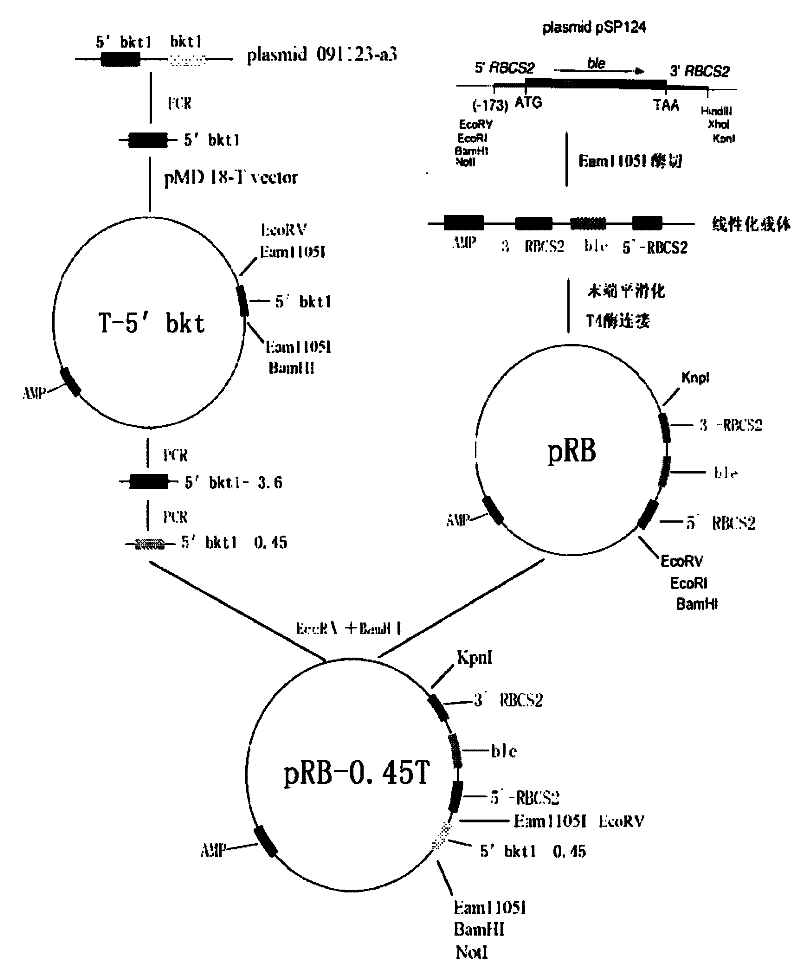Preparation method of T vector capable of cloning microalgae promoter and application thereof
A promoter and vector technology, applied in biochemical equipment and methods, microbial assay/inspection, introduction of foreign genetic material using vectors, etc., can solve problems such as hindering research work, impossibility of promoter regulation function, research, etc.
- Summary
- Abstract
- Description
- Claims
- Application Information
AI Technical Summary
Problems solved by technology
Method used
Image
Examples
Embodiment 1
[0063] Example 1: Construction of Microalgae Promoter Cloning T Vector
[0064] (1) Using pBle1 / pBle2 (pBle1: 5'-GTAGATATCATGGCCAGGTG-3', pBle2: 5'-GCGGGTACCTTAATTAAGCTTC-3') as primers, by PCR from plasmid pSP124 (preserved in our laboratory, purchased from American Algae Bank) The ble-3'RBCS2 terminator with a size of 970bp was amplified (94°C for 3min; 94°C for 1min, 58°C for 1min, 72°C for 1min, 25 cycles; 72°C for 10min), and cloned into pMD 18-T (TaKaRa Company) In the vector, the T-p124 plasmid was obtained and confirmed by sequencing. The ble-3'RBCS2 terminator was obtained by EcoRⅤ+KpnI double digestion of plasmid T-p124, which was inserted into the EcoRⅤ+KpnI site of the pSP124 vector, and finally the pB124 vector was obtained.
[0065] (2) Construction of pB vector: the pB124 vector was single-digested with Eam1105I to obtain a linear vector, and then the end of the vector was smoothed by T4DNAPolymerase, and the original Eam1105I site was mutated. The vector was ...
Embodiment 2
[0070] Example 2: Cloning of the promoter of the carotene ketolase gene from Haematococcus pluvialis
[0071] (1) Preparation of T carrier
[0072] The pB-0.45T and pRB-0.45T vectors were double digested with Eam1105I, separated by 1% agarose (mass volume ratio) gel electrophoresis, and large fragments were obtained, using the EZ-10 Spin Column DNA Gel Extraction Kit kit (TaKaRa Company ) reclaim the DNA fragments of the agarose gel, and the obtained DNA fragments can be used as the T carrier of T / A cloning;
[0073] (2) Insertion of the microalgae promoter fragment
[0074] Using pcrto5 and pcrto6 (pcrto5: 5′-CAGCTAGATGACTGCCTCAC-3′ pcrto6: 5′-CGTCTAGCTGTGCTATGGC-3′) as primers, a product with a size of 200 bp was amplified from the 091127-a3 plasmid by PCR (94°C 3min; 94°C 1min , 55°C for 1min, 72°C for 50sec, 5 cycles; 94°C for 1min, 58°C for 1min, 72°C for 50sec, 30 cycles; 72°C for 10min), the 5′bkt1(-200 / -1) promoter was obtained and named 5'bkt1-0.2.
[0075] T vect...
Embodiment 3
[0076] Example 3: Analysis of the promoter function of the carotene ketolase gene of Haematococcus pluvialis
[0077] (1) Genetic transformation of foreign genes
[0078] The genetic transformation of Chlamydomonas reinhardtii CC-849 (preserved in our laboratory and purchased from the U.S. Algae Bank) was carried out using the bead milling method. The specific steps are as follows: (1) CC-849 was placed under continuous light (about 90 μE / m 2 / s), cultured in TAP medium (self-prepared, see Table 1) to the logarithmic phase, the number of cells is about 1~2×10 6 Cells / mL can be fixed with Lugol's solution, and then counted by hemocytometer; (2) 5000rpm, 5min, 23°C centrifuge to collect CC-849; (3) Remove the supernatant and resuspend the pellet with sterilized TAP (not too violent), adjust the cell concentration to 2×10 8 cells / mL; (4) Pipette 300 μL of the suspension into a 1.5 mL test tube, which is pre-installed with 0.3 g of sterilized glass beads with a diameter of 0.4 m...
PUM
 Login to View More
Login to View More Abstract
Description
Claims
Application Information
 Login to View More
Login to View More - R&D
- Intellectual Property
- Life Sciences
- Materials
- Tech Scout
- Unparalleled Data Quality
- Higher Quality Content
- 60% Fewer Hallucinations
Browse by: Latest US Patents, China's latest patents, Technical Efficacy Thesaurus, Application Domain, Technology Topic, Popular Technical Reports.
© 2025 PatSnap. All rights reserved.Legal|Privacy policy|Modern Slavery Act Transparency Statement|Sitemap|About US| Contact US: help@patsnap.com



